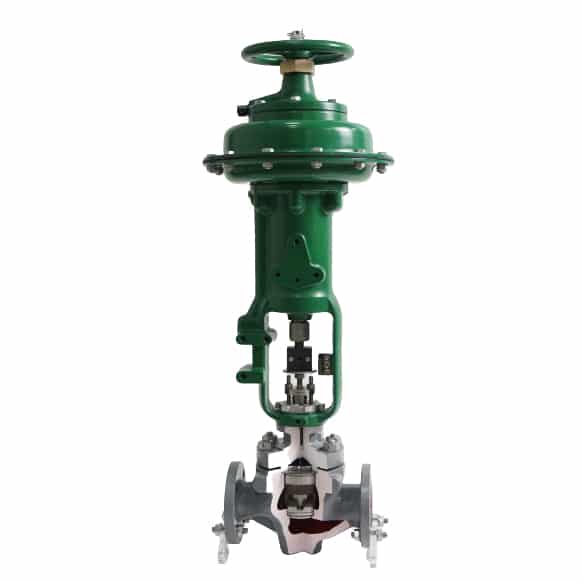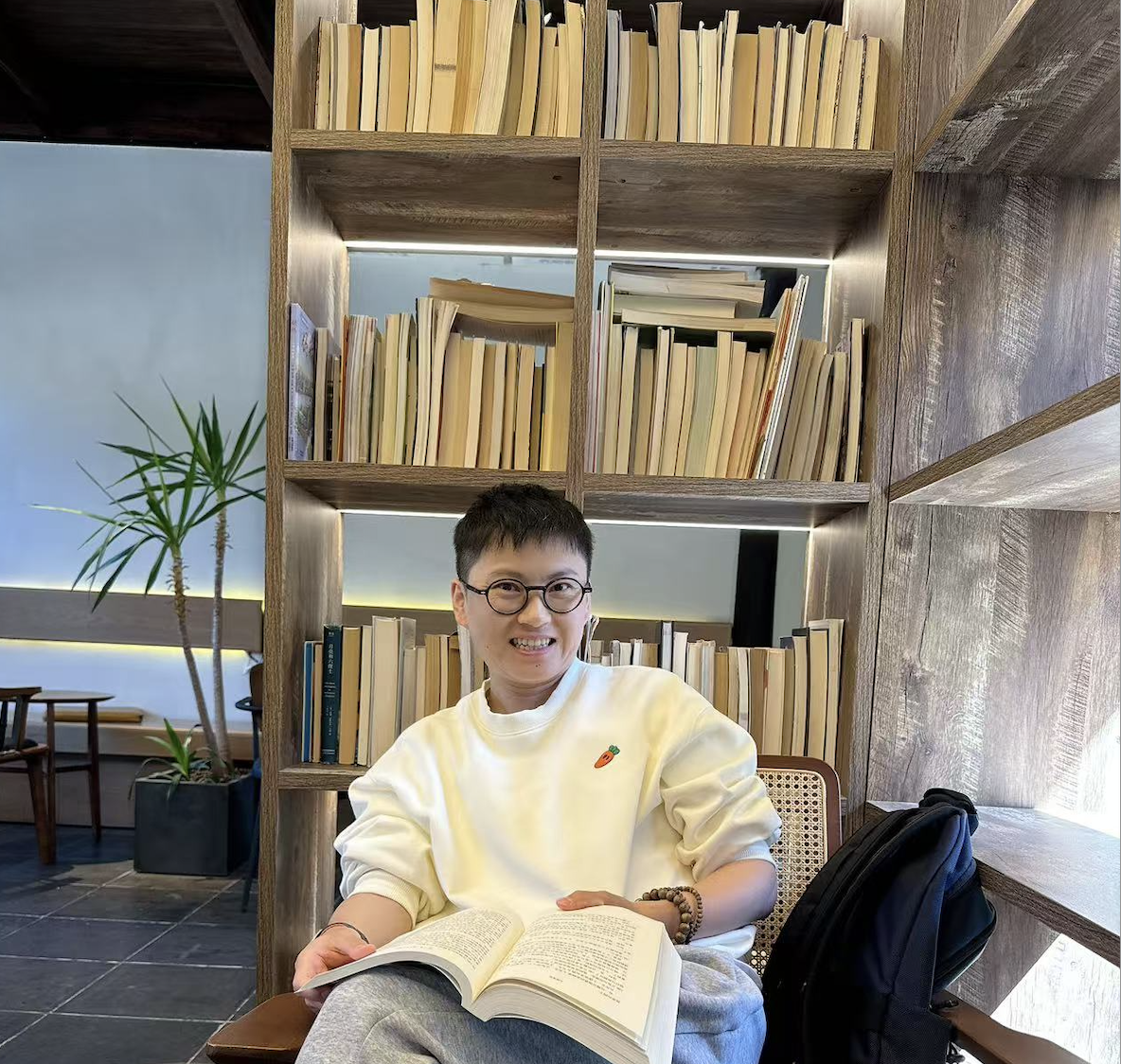Thermal Power Station Process
Classified by total installed capacity for power plant:
- Small-capacity power plants (total installed capacity<100 MW)
- Medium-capacity power plants (total installed capacity 100-250 MW)
- Large and medium-capacity power plants (total installed capacity 250-600 MW),
- Large-capacity power plants ( Total installed capacity 600-1000 MW)
- Extra-large capacity power plants (total installed capacity>1000 MW)
Classified by steam pressure and temperature for power plant:
- Medium and low pressure power plants (steam pressure 3.92MPa, temperature 450 degrees, single unit power <25 MW)
- High-pressure power plants (Steam pressure 9.9MPa, temperature 540 degrees, single unit power <100 MW)
- Ultra-high pressure power plant (steam pressure 13.83MPa, temperature 540 degrees, single unit power <20 MW)
- Subcritical pressure power plant (steam pressure 16.77 MPa, temperature 540 degrees) , Single unit power 300 -1000 MW)
- Supercritical pressure power plant (steam pressure> 22.11MPa, temperature 550 degrees, single unit power> 600 MW)
- Ultra supercritical pressure power plant (steam pressure> 33.5MPa, 610℃/630℃, Single machine power> 600 MW)
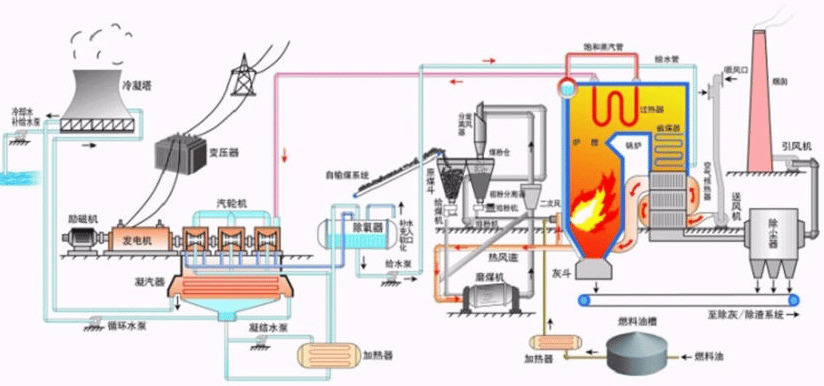
Power Plant Valves
1. Power Plant Valves Used in Condensing System
a) The condenser circulation control valve is the same as most centrifugal pumps. The condensate pump needs a minimum flow to avoid overheating and protect the pump from cavitation damage. Therefore, a circulation loop is added from the outlet of the pump to the return condenser. The fluid temperature of this loop is between 38°C and 66°C and the pressure is between 400Psi and 600Psi. The condenser loop valve must be able to absorb the entire pressure drop. Such a high-pressure drop will cause cavitation to a general valve.
b) Liquid level control valves is to ensure the liquid level of the deaerator. It controls the water flow from the condenser to the deaerator. The working condition of this valve variation of directly with the load. When the pump is started, the load of the pump is very small, the inlet pressure of the valve is high and the outlet pressure is low. This is because the pressure in the deaerator has not been established. In this case, it is necessary to avoid cavitation and the flow is small. When the factory load increases, a large flow is required, and the condensate pump no longer maintains the same pressure. This causes the inlet pressure of the valve to decrease. At the same time, the pipeline’s pressure on the deaerator is building up, and it will in turn act on the valve. Keep a large flow under the action of a lower pressure drop requires a valve with high flow capacity to reduce the resistance acting on the valve trim.
Control requirements: provide flow to maintain the normal water level of the deaerator, and increase the water temperature by entering steam to eliminate the gas dissolved in the water.
Working condition: The flow is small at the start-up stage and the pressure difference is large. Under normal conditions, the flow is large and the pressure difference is small. The working condition is similar to the water supply valve.
Valve requirements: effective anti-cavitation at lower flow rates.
2. Power Plant Used in Boiler water Supply System
Working condition requirements: when the boiler starts, the differential pressure can reach 100-300 bars. When the flow rate is small, and differential pressure is small during normal operation. When the flow rate is large, the flow rate adjustable is 75:1 to 100:1. It should be noted that to eliminate the dissolved oxygen in the water, hydrazine will be added for treatment, which will cause adverse reactions to SATELLITE 6 alloy or other similar alloys, so we suggest not using the 316+STELLITE hardening surfacing to process the valve, instead to select 416 stainless steel materials.
a) The boiler feedwater pump circulation control valves also called the minimum flow control valves, need to remain at a minimum flow rate during the startup and shutdown period to avoid damage. In addition, when the boiler feedwater volume exceeds the required rate, the excess rate will be directly returned to the feedwater tank through the opening circulation control valve. Make the boiler feedwater pump start and run safely, and eliminate the damage to the pump due to low flow, temperature rise, and strong cavitation, and the pressure drop can reach 160-350 bars. It is the largest differential pressure in the power station system, and the flow is generally normal. 30% of it.
Usually, there is a high differential pressure between the pump outlet and the feedwater tank. This differential pressure is reduced by a multi-stage pressure reduction minimum flow control valve. According to this requirement, this control valve needs to be able to work in both on-off and continuous control functions. The valve trim is in the form of a balanced plug, with an anti-blocking structure, pressure reduction is achieved through labyrinth or cascade pressure reduction or cyclic convection valve cage to avoid cavitation. The number of pressure reduction stages is selected according to the differential pressure. The seat leakage must comply with class level V. When the pump starts and stops, the valve works continuously during operation. After the pump is started normally, the valve is closed again, so it is usually the valve failure position is open.
b) The main feedwater control valve. If the feedwater pump does not have speed control, the feedwater control valve is used as a control valve when the load is 100%. The feedwater control valve is often used when the boiler load is started (with or without a variable speed pump) with stable control performance. The cage and valve plug are specially designed for the feedwater control valves, in case achieve tightness and high durability. In the small opening control, the standard labyrinth valve trim and the multi-holes cage control valve will inhibit cavitation inner of the trim.
At full load, this control valve can achieve the expected best efficiency with the smallest pressure drop and the largest flow rate. When the boiler starts, this control valve should have a high-pressure drop and a small flow. To meet the above two functions, the control valve must have a large adjusting ratio. It means this control valve is equivalent to the function of two valves. 30% of the start valves (bypass) usually use labyrinth valve trim and at full load select multi-holes cage type control valve with leakage class V.
c) Boiler feed water start valve Many power plants use a start valve and a main valve to complete the above functions. The start valve must meet the requirements of small flow and cavitation resistance, while the main valve must meet the conditions of large flow with low differential pressure, and the labyrinth type control valve could meet all requirements.
The working conditions of the boiler feedwater start valve and the boiler feedwater pump circulation valve are roughly similar, which is high inlet pressure and full pressure drop. This valve requires anti-cavitation and shut-off tightness but does not request anti-cavitation protection when all valves are in operation. Therefore, the cage control valve of the labyrinth trim can meet this working condition. Under normal situations, we recommend the use of a small-port high-pressure angle type control valve with labyrinth trim.
d) Desuperheater control valve. To control the temperature in the last stage of the superheater, the desuperheater control valve requires a high-efficiency spray valve to complete. Also in the steam reduction device, the cooling water needs to be closed sometimes. At this time, a very high pressure acts on the components, and a large pressure drop passes through this valve. Considering such a high-pressure drop, a variety of different throttling plugs can be used to meet it. For pressures exceeding 300 PSIG, use a multi-holes cage first-stage control valve. When the pressure exceeds 600 PSIG, a two-stage pressure-reducing control valve assembly is used. When the pressure exceeds 900 PSIG, three-stage labyrinth trim pressure reducing assembly is used. The structural design allows the replacement of the valve seat and plug, trim to be replaceable in-site in a short period.
e) The boiler regular blowdown valve and continuous blowdown valve used in high temperature, and high differential pressure, anti-cavitation, angle valve is the best choice.
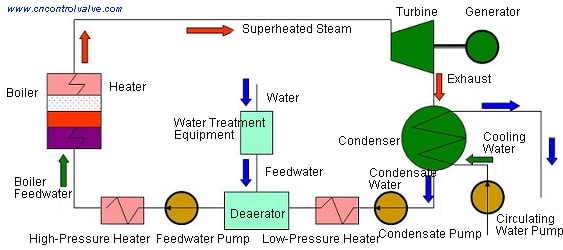
3. Power Plant Valves Use in Main Steam System
The main steam system contains the components from the boiler outlet to the condenser. It includes from the superheater to the high-pressure steam turbine and then through the reheater to the low-pressure steam turbine, finally exhausting the energy of the steam, returning to the condenser to start a new process. 5 important typical valves are used in this main steam system, including water desuperheat control valves for superheater and reheater desuperheating, bypass valves for high-pressure steam turbine, and low-pressure steam turbine, and blowing control valves. These valves contain a variety of complex working conditions, including high pressure, high temperature, cavitation, noise, boiler type, storage tank type, and whether it is straight or not. These factors have a great impact on the control valve. Direct-discharge supercritical boilers usually require larger valves for larger units. They also operate under higher main steam pressure. there are some special valves used in direct discharge on the boiler.
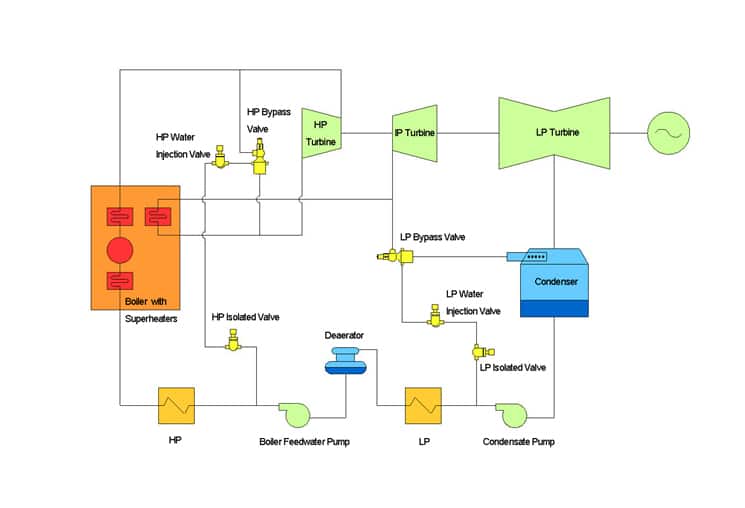
a) High-pressure steam turbine bypass valve
The high-pressure steam turbine is in the form of a high-pressure angle valve. The pressure is reduced by the valve trim. The high-pressure steam turbine bypass system provides an alternate flow path for high-temperature and high-pressure steam. It bypasses the steam turbine and flows into the reheat section. When the steam turbine is abnormal or during start-up operation, this bypass system can ensure the stable operation of the entire boiler system. At this time, steam flows through the high-pressure bypass valve, and the outlet temperature of the bypass valve is slightly higher than the normal high-pressure through the water injection control valve. The temperature at the outlet of the steam turbine. This control system must be able to quickly open the valve and continuously adjust the feedback according to the set temperature and pressure. The valve opening time is generally not more than 5 seconds. When this bypass valve is working, it must be able to provide the same pressure drop and cooling functions to protect the reheater part of the subsequent boiler from damage. In addition, it can quickly unload the steam turbine when the boiler is not intermittent. Bypass is generally a device that discharges the main steam directly into the condenser through temperature and pressure reduction without passing through the steam turbine. The high and low-pressure bypass system has three functions: start, overflow, and safety. Its structure is similar to that of an integrated pressure reducer. Because of higher pressure and higher temperature, it has higher requirements on the reliability of materials and valves. The valve is generally closed, and the seat leakage class is higher than Class V, and it needs to be quickly open within 3 to 5S.
Control requirements: adjust the high temperature and high-pressure steam to a certain temperature and pressure; provide a bypass channel for the steam turbine, and the boiler can work independently of the steam turbine.
Working condition: reduce temperature and pressure.
Valve requirements: resistance to thermal shock, noise reduction, and fast response.
b) Low-pressure steam turbine bypass valve
The low-pressure bypass system provides a bypass channel for the low-pressure steam turbine to control steam pressure and temperature. Regardless of whether the high-pressure bypass system is running or not, the low-pressure bypass valve receives steam from the boiler reheater and then adjusts the steam to enable received by the condenser. Through the throttling of the valve and the large-flow desuperheating water spray, the high temperature and high pressure are reduced. The temperature control requirements are not too strict, the purpose is only to protect the condenser. This protection is achieved by water spraying and quick shut-off. The application of low-pressure bypass or condenser application general to consider production process conditions of low-pressure bypass: high pressure, high temperature, noise, valve tightness, and temperature reduction requirements.
c) Soot blowing control valve
A high-quality control valve is required for soot blowing pressure control. In the soot blowing cycle, because the flow rate changes greatly, the valve is required to have a larger flow rate adjustment ratio. When the soot blowing system is switched on and off, the control valve must be fast React to avoid pressure shocks, thereby ensuring the safety of the pipeline. Due to the high temperature and pressure, the pressure level of the valve is required to be high, and useful steam cannot be wasted, so it must be tightly closed. The soot blowing valve usually has to operate many times in a day. The operating temperature of this valve must be able to meet the entire operating temperature range. In addition to the effect of temperature, a high-pressure drop will cause strong noise, as well as damage and vibration to the valve core. Therefore, the spool designed for this application must have high performance. Taking into account the above considerations, high noise and frequent actions are important factors that cause problems, we choose a labyrinth spool to meet this working condition. The valve reduces the flow rate. , With a wide adjustment ratio, the valve trim adopts an unbalanced design and uses a large torque actuator to ensure tight shut-off.
e) Auxiliary steam control valve
The auxiliary steam of different equipment is obtained by reducing the pressure of the main steam. Due to the high-pressure drop, it will cause vibration and noise. This type of control valve must avoid vibration and noise. It requires a wide flow adjustment range, and the structure and materials must be suitable for high pressure and temperature.
f) Deaerator limited steam control valve
The deaerator is similar to a heater (the steam and feed water are mixed in the heater), and it is also designed to remove incompressible gases in the feed water. These gases include oxygen and carbon dioxide, which can damage and corrode pipelines and boilers. The straight pipe is usually mixed with hot steam and the feed water of the deaerator to make the temperature reach saturation temperature so that incompressible gas can be removed. For the drum boiler, the steam extraction is auxiliary from the main steam pipe. Obtained from the pipeline. For tube boilers, the steam is extracted from the flash tank or the end of the high heater. This will be lower than the pressure of the drum boiler. The steam pressure is usually higher than the required pressure, so it must be reduced. This The valve needs to consider the problem of noise. The deaerator’s limited steam valve requirements are more stringent because the noise is relatively high, some noise reduction equipment will be used.
g) Steam turbine sealing pressure control valve.
h) Traps are available in ball valve type and globe valve type.
The valve body is generally forged, with materials such as A105, F22, F91, etc., with a general diameter of 1-3″, pressure class 150-4500#, the actuator includes manual and electric.
4. Heater water delivery system
A typical power plant has two sets of feedwater heaters: the low-pressure heater comes out of the condensate pump and enters the deaerator when the heating is close to saturation, and the other set is called the high-pressure heater, which heats the deoxygenated water from the feedwater pump so that the high pressure is close to saturation. The deoxidized water in the state enters the boiler. The working principle of the two systems is the same. The difference is the heating medium. In the low-pressure heater, the steam discharged by the low-pressure steam turbine is commonly used. The high-pressure heater uses reheated steam and part of superheated steam. The feedwater heater is an exchanger of the shell and the heat pipe. After the steam enters, it is cooled and condensed into a liquid. In this process, the heat is transferred to the water. The liquid level of the heater condensation must be controlled efficiently. Therefore, the drainage system in the two heater systems is quite accurate. This leads to a vacuum in the condenser. The problem is that the condensate loses pressure and flashes after being discharged into the condenser. The flashing fluid will damage the control valve and pipelines. When choosing this valve, consider low flow resistance and reduce the flow rate as much as possible to avoid damage to the valve by flashing to the minimum.
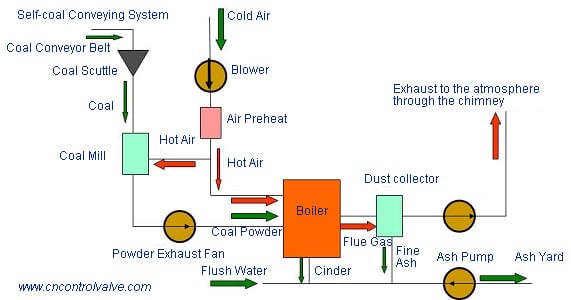

a) High-pressure heater water delivery control valve
For the high-pressure heater water delivery system, the control valve is required to ensure stable pressure. First, it is recommended to use A217-WC9 (A182-F22) or A217-C5 (A182-F5) alloy steel, with a hard alloy treated valve plug, material Abrasion resistance, and impact resistance are required. When the pressure level is as high as ANSI1500LB, an angle type is recommended in case to avoid abrasion. The use of a labyrinth for the valve plug can reduce the flow rate as low as possible.
Control requirements: control the position of the condensate in the heater, discharge the condensate in time, that is, discharge at a high water level, and drain the normal water level.
Working conditions: The medium is saturated water, the pressure difference between the control valves of the heaters is generally 6-30bars, and the last-stage trap is directly connected to the condenser or deaerator.
Valve requirements: anti-flashing erosion, V or VI sealing level, the valve is usually open for failure.
b) Low-pressure heater drain control valve
For the low-pressure heater drain system, general use straight-through valve type, and WC9 material, the valve plug is heat-treated.
c) Fuel and gas control valve
Fuel: Seat leakage is not allowed, and a quick response is required in emergency situations.
d) Three-way valve for the high-pressure heater
This type of valve is designed to provide a bypass for high-pressure feedwater, welding, trap systems fail, or high-pressure heaters that need to be overhauled.

